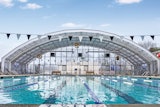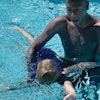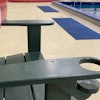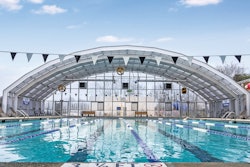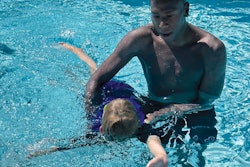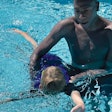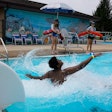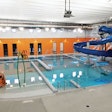Following 10 important steps before, during and after a critical incident can keep swimmers safe and aquatic facility operators out of legal trouble.
 Photo of a lifeguard performing CPR on an unresponsive swimmer
Photo of a lifeguard performing CPR on an unresponsive swimmerWhen an aquatic facility opens its doors every day, its staff members should assume that an incident could occur that will require the implementation of an emergency action plan. While the likelihood is small that such an incident actually will take place - based on recent lifeguard surveys, experts consider more than one life-saving attempt per year per lifeguard at a public pool to be high - all employees still must be prepared for the worst.
"Aquatic facilities have hazards," says Alex Antoniou, director of educational programs for the National Swimming Pool Foundation, which this year launched two online training courses on aquatic risk management and emergency response planning. "Managing the risk can make the difference between prosperity and catastrophe."
But managing the risk also can seem like a tedious task. "When you've been guarding for five years, you might work 1,000 hours for five rescues," say Jim Wheeler, neighborhood and aquatic services manager for the city of San Francisco's Recreation & Park Department, as well as owner of Total Aquatic Management, a training and safety consultancy. "So lifeguards spend a whole lot of time looking at a whole lot of noncritical events, waiting for one critical event to occur. And that can definitely lull them into a false sense of security. Lifeguards need to understand that rescues are rare and random, and the job can be monotonous."
According to the U.S. Centers for Disease Control and Prevention, the majority of drownings, especially among young children, occur in residential swimming pools. But critical incidents at commercial pool facilities aren't limited to drowning episodes. In fact, broadly defined, a critical incident can include anything that requires a victim to receive CPR, spinal mobilization or hospitalization - such as a diving injury, recreational water illness, or hypoxia (insufficient oxygen supply to body tissue) or anoxia (complete lack of oxygen in the body) brought on by prolonged underwater breath-holding.
When he defines the term, Jeffrey Mitchell, a clinical professor of emergency health services at the University of Maryland, also takes into consideration how a critical incident impacts employees and facility operations. He says a critical incident is any situation faced by rescue personnel that causes them to experience unusually strong emotional reactions - reactions that have the potential to interfere with their ability to properly function, either on the scene or after the fact.
Wheeler developed a 10-step plan to help facility operators and employees prepare for and manage critical incidents, including a "defusing" process that assists employees in coping with post-incident effects. "For a long time, people asked me to come and tell them horror stories," he says. "I could tell you a horror story about a guy getting his eye popped out with a surfboard or falling off a high-dive tower and landing on his head. There are a lot of stories that can scare guards into being ready. But we try to do it from a duty-based point of view. I don't want to talk about what happened and how much it cost; I want to talk about how we prevent things. It's a more positive way to approach the whole subject. We want lifeguards to understand their duty, and part of that duty is to minimize risk in order to prevent loss."
A major part of loss prevention is simply doing business correctly, including documenting everything - especially in the face of media and jury scrutiny. Make sure that certification records for lifeguards are on file and easily accessible, for example, and that health codes regarding water quality and sanitation are strictly followed. "It may not be a water quality issue that led to your critical incident, but when investigators come in and start looking around, you'll get graded," Wheeler warns. "Are you an A operator, a B operator or a C operator?"
Here are Wheeler's 10 steps to help ensure that your facility receives a good grade:
1) BE PREPARED. If you don't already have one, develop an emergency action plan that includes policies and procedures regarding, among other things, which employees should be responsible for which tasks in the event of a critical incident. "We try to prepare the lifeguards to be the primary handlers of the critical incident," says Wheeler, a former lifeguard who now oversees nine public pools in San Francisco. "Then, at least once a year, we train everybody else - cashiers, concessionaires - and help them figure out what their roles would be. Cross-training is essential."
Review the location and proper use of on-site emergency equipment, including first-aid kits, fire extinguishers, personal protective equipment, automated external defibrillators, oxygen sources, spine boards and blankets. Ensure that employees know where the mechanical room is located and how to gain entry and operate controls. Easy access to Material Safety Data Sheets is critical, too. A full collection should be stored in the main office, with additional copies for every chemical used on-site kept in the mechanical room. Facility inspections, such as checking for slippery spots on decks and loose or sheared bolts on diving boards, also should become regular habits.
Wheeler suggests quizzing staff members in all of these areas before each operational season, as well as requiring one-hour refresher sessions throughout the season. In addition, all employees should know basic first-aid skills and have access to a phone list with relevant numbers for local emergency personnel, medical facilities and staff supervisors.
2) CATER TO THE VICTIM'S FIRST NEEDS. Although all staff members may be familiar with first-aid procedures, Wheeler says lifeguards should be the ones to administer aid to victims - even in non-emergency cases. CPR can be performed wherever the victim's body is situated. But in cases in which an AED must be used, the victim should be moved at least 15 feet away from the water for safe use in a dry environment.
When performing CPR or some other emergency procedure in particularly critical situations, the pressure on lifeguards, who typically range in age from 16 to 20, is that much greater. Says Wheeler, "One of the biggest problems we have in our industry is that there's no way of knowing whether a kid can perform CPR on a dead body until he has a dead body to perform CPR on."
Wheeler recommends that facilities provide adequate supervision on the deck and layer protection around the pool with head lifeguards, senior lifeguards and even a pool manager. Some facilities have updated their emergency response capabilities to include wireless, strategically placed "all call" buttons on decks and even on lifeguards' whistles or lanyards. When activated, the alert signals fellow guards and other pool personnel that an emergency is in progress.
"The best skill that a good pool manager can have is an arm sweep to move the ineffective lifeguard out of the way and take care of business," Wheeler says, adding that he's seen such a skill save lives. "In order to do that, they have to be on the pool deck and ready to go. A pool manager is a pool manager, not an office manager."
3) CALL EMS CREWS. Which crews to call depends on the situation. When in doubt, 911 works every time.
One of the best ways to foster strong relations with local EMS organizations is to invite them to join your staff for a preseason meeting. Have employees and EMS workers introduce themselves, discuss response times to the facility from nearby police and fire stations, and review such crucial details as the location of emergency gates and their keys, access issues regarding the parking lot and pool deck, potential triage spaces for victims who need to be moved away from onlookers, and protocol regarding what tasks - such as the fitting of a cervical collar on a spinal-injury victim - should be delayed until EMS personnel arrive.
Additional training can involve techniques for employees and supervisors to remain calm in the face of a crisis.
4) EFFECTIVELY HANDLE BYSTANDERS. An employee not directly responding to the victim - perhaps a concessions or maintenance worker - should step in to at least corral bystanders away from the scene and assure them that the situation is under control. "Hopefully, in your emergency action plan, everybody's got a job," Wheeler says. "And one of those jobs would be crowd control and evacuation."
The decision to evacuate depends on the severity of the situation. If it is a life-and-death matter that is taking all lifeguards on duty away from their posts, the facility should be cleared immediately. Plus, as Wheeler says, "the more people who see the incident and the more witnesses that a plaintiff's attorney goes out to find, the more stories you may be sifting through to find the truth. You'd be amazed at the different stories you get when you try to take witness statements from a lot of people."
5) SECURE THE FACILITY. Again, the extent of this measure depends on the nature of the incident. If it involves nothing more than a standard rescue, chances are that you will only need to cordon off the area in which the incident occurred. That will allow ample room for lifeguards and emergency personnel to provide care to the victim, while other lifeguards can take their usual posts around the pool.
If the incident resulted in a fatality or perhaps involves a chemical leak, full evacuation should be considered, Wheeler says. In such cases, designated employees should be in charge of ensuring that all patrons have left the premises, and that the facility's doors, gates, cash registers, locker rooms and concessions areas are secure.
6) NOTIFY SUPERVISORS. As soon as the victim has been stabilized - and after all EMS personnel have been called - a designated employee should notify any supervisors, facility managers and other relevant officials not on-site that a critical incident has occurred. Wheeler recommends making sure the previous five steps have been followed first, thus ensuring the safety of the victim and other patrons at the facility.
7) HOLD A STAFF-DEBRIEFING SESSION. Wheeler prefers to refer to this step as a "defusing" session, allowing staff members to share their initial reactions, vent their fears or frustrations and provide a support system for each other.
Such sessions typically should be held within one to four hours after the conclusion of the critical incident, and while tending to the emotional needs of employees is important at that time, other serious business also needs to be conducted. "It's an opportunity to go over the facts, an opportunity for people to check in on what they saw and make sure you have all the information you need for the incident report: date, time, location, who provided care, things like that," Wheeler says. "All of those things are critical to good documentation, should you get into the litigation side of things."
8) KEEP THE MEDIA AT BAY. Most commercial pool facilities, whether public or privately owned, designate a media contact, and only that person is allowed to give public statements - preferably prepared ones that include facts about the incident, as well as supplemental information such as the number of lifeguards the facility employs, the amount of training each one undergoes every season and the number of patrons that safely enjoy the pool each year, says Wheeler. All other employees, he adds, should be in "no comment" mode.
This approach to the media should be followed consistently, regardless of the severity of the critical incident.
9) FILL OUT ALL RELATED PAPERWORK. This step involves the incident report, which should be filled out as soon as possible after the critical incident has been resolved. It is perhaps the most important step in the process after ensuring that a victim has been stabilized, Wheeler says, because incident reports can become legal documents.
The process of filling one out, however, may be daunting to a 16-year-old part-time employee who has never seen one before. So supervisors shouldn't hesitate to assist them by encouraging thoroughness and objectivity, but they should afford the lifeguard or the employee who responded to the critical incident the latitude to document events as he or she witnessed them. It's also a good idea to include an example of a properly filled-out incident report in all employee manuals.
Wheeler says a worthwhile exercise to assist staff members in writing incident reports involves showing them a video of a staged incident and its aftermath, and then requiring each employee to write his or her observations: What happened? What type of care was provided? Who administered it? This will help them focus on the facts.
10) HOLD ANOTHER STAFF-DEBRIEFING SESSION. Conducted one or more days after the critical incident, this will provide an opportunity for workers to share post-incident reactions some time after the initial staff-debriefing session outlined in Step 7. Require every person who was working when the critical incident occurred to attend, and invite a local mental-health professional to assist those employees still troubled by what occurred.
Studies show that lifeguards who lose a victim to drowning, entrapment or other means can suffer from anger and isolation issues, a guilt complex, sleeping difficulties, social withdrawal, flashbacks and depression.
There is no shortage of programs to help improve risk management and emergency response procedures at pool facilities. In addition to Total Aquatic Management and NSPF, several organizations around the country - including Aquatic Safety Research Group, DeRosa Aquatic Consulting, Jeff Ellis & Associates Inc., the National Aquatic Safety Company and the Starfish Aquatics Institute - offer risk management programs for pool operators. And with good reason. "Drowning, disease, chemical exposures or injuries jeopardize customer loyalty and can bankrupt the facility and destroy careers," says Thomas Lachocki, NSPF's chief executive officer.
That's a lot of pressure to place on the shoulders of a teenage lifeguard. And no matter how much a facility manager stresses prevention and readiness, it's next to impossible to know exactly how a lifeguard or other employee will react in an emergency situation. "We're just trying to build a better kid who is more prepared to deal with things like this and can do so on cruise control," Wheeler says. "But every kid handles it differently. You wish you could put them in a little room and watch how they react to every situation before you put them on deck. But you can't, so you just train them, put them out there and hope."









